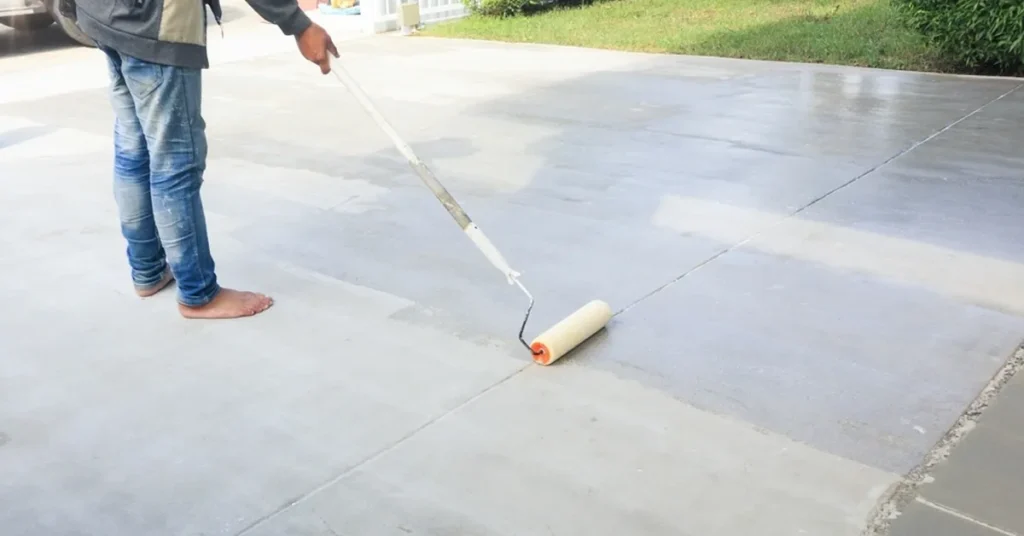Concrete is strong, but it is not perfect. Over time, you may see cracks showing up in your driveway, patio, or indoor concrete floor. They might start small and grow slowly. Or they might appear suddenly after heavy rain, a hot summer, or a winter freeze..
These cracks may look like nothing at first. But if you leave them alone, they can grow deeper, wider, and more expensive to fix later. Some cracks just make things look bad. Others can cause water to seep in, weaken the surface, or even lead to safety issues if someone trips.
The good news is that you can fix most of these cracks without needing a pro. With a little care and the right method, you can handle it yourself and make your concrete look good again.
Let’s go over why cracks form and how to fix them correctly.
Why Concrete Cracks
Concrete is hard, but it changes with the weather. When it’s hot, it expands. When it’s cold, it shrinks. This movement causes stress inside the slab. If the concrete can’t handle the stress, it cracks. Concrete can also crack if the ground underneath it moves or sinks. This happens when water gets under the slab or the soil is not packed down properly before the concrete is poured.
Tree roots can push from underneath. Heavy vehicles or objects can press down too much in one spot. Even concrete that was mixed or cured too fast can end up with cracks. Not every crack means there’s a serious problem, but it is always better to fix them early.
Check the Crack Before You Start
Not all cracks are the same. Some are narrow and short. These are called hairline cracks. They look like thin lines and don’t go very deep. They are mostly surface problems and are easy to fix. Other cracks are wider or deeper. You might be able to stick a coin inside. These are more serious. Sometimes, they come from movement under the slab or pressure from above. These cracks may need a little more care when repairing.
Some cracks also look like big open lines with crumbling edges. These can mean the concrete is weak in that spot. If the surface feels hollow or loose, you may need to remove a small section and patch it. Before doing anything, clean the area well. Sweep away dirt, leaves, or dust. A clean surface helps you see how deep and wide the crack is and helps the repair material stick better.
Fixing Small Cracks in Concrete
If the crack is thin, like a hair or thread, you are in luck. These cracks are not deep and are easy to repair. You can use a ready-made concrete filler. These are often sold in tubes, bottles, or squeeze pouches. They are made to fill cracks and dry hard. After cleaning the crack, apply the filler slowly along the line. Use a small putty knife or even an old credit card to press the filler down into the crack. This makes sure it reaches the bottom and does not leave any air gaps.
Once it is filled, smooth the surface so it blends in with the rest of the concrete. Wipe away any extra filler before it dries. Let it cure as long as the label says. Most fillers dry in a few hours, but some need a full day. When it is dry, the crack should be sealed, smooth, and barely noticeable.
Fixing Bigger Cracks in Concrete Driveways, Patios, and Slabs
Larger cracks need a little more effort. If the crack is wide or deep, or the edges crumble, you will need a patching compound instead of a simple filler. First, use a chisel or screwdriver to open up the crack slightly. This helps the patch stick better. You do not need to dig deep. Just shape the crack into a wider base so the new material stays in place.
After that, use a brush or vacuum to clear out all loose bits. Any dust or debris left inside will keep the patch from sticking. Next, you can apply a concrete bonding liquid. This is not always required, but it helps the patch grip the old concrete. Mix the patching material as the instructions say.
Some patches come dry and need water, while others are pre-mixed. Either way, fill the crack fully and press it in with a trowel. Smooth the surface to match the rest of the area. Let the patch cure without touching it. Avoid walking or driving over it until it is fully dry. This may take a day or more, depending on the product.
What About Cracks in Concrete Slabs
Cracks in concrete slabs, like floors or garages, follow the same steps. Clean the area, check the depth of the crack, and use either a filler or a patch, depending on the size. Indoor concrete often has a smoother finish, so try to match the repair to that finish. You can use a damp sponge to blend the patch into the rest of the floor. If the slab is painted or sealed, you may need to repaint or reseal the area afterward. Slabs may also have cracks from settling, so if the crack keeps coming back after repairs, you may need to look into the base under the slab or call in a professional to assess the foundation.
Prevent Cracks from Coming Back
Even after you fix the cracks, it is smart to take steps to keep them from coming back. You cannot stop all cracks forever, but you can make them less likely. Start by sealing your concrete. A good concrete sealer protects the surface from rain, snow, oil, and temperature changes. It also prevents water from soaking in and causing damage below the surface.
Also, check the drainage around your concrete. Make sure water flows away from your driveway or patio. If water sits on the surface or flows underneath, it weakens the slab over time.
Avoid placing very heavy loads in the same spot. If you park a truck or trailer in the same place on a concrete driveway, that pressure adds up and may lead to cracks. If your patio or walkway is near trees, trim back roots and watch for raised areas in the concrete. Roots can push up from below and create stress that causes cracks.
Fixing Cracks Saves You Money
Some people ignore small cracks, but waiting too long can make them worse. Water can get in, freeze in the winter, and expand, breaking the surface even more. Dust and dirt collect inside the cracks; before you know it, the small problem becomes a big repair. Fixing cracks early keeps your space looking clean. It also helps prevent tripping or damage to things like furniture, tires, or bikes that roll over it. A clean, solid surface is easier to walk on and clean, and better for your home’s value.
Tools and Materials You May Need
Here are some things that come in handy when fixing concrete cracks:
- Concrete crack filler or patch compound
- Putty knife or trowel
- Wire brush
- Broom or vacuum
- Concrete bonding adhesive
- Clean water and a sponge
- Sealer to protect the area afterward
You can find most of these at local hardware stores or online. Many of the products come with instructions, and most small jobs can be done with basic tools.
FAQs
What causes cracks in concrete driveways and patios?
Cracks form due to weather changes, ground movement, heavy loads, or poor drainage. Over time, these pressures create gaps in the concrete surface.
Can I fix concrete cracks myself, or do I need a professional?
Most small to medium cracks can be fixed at home with basic tools, store-bought fillers, or patching compounds. Larger structural issues may need expert help.
What’s the best way to clean a crack before repair?
Use a wire brush to scrub the crack, then sweep or vacuum out all dirt and dust. A clean surface helps the repair material stick better.
What is the difference between filler and patching compound?
Filler is used for thin surface cracks, while patching compound works better for wide or deep cracks. The right choice depends on the crack size.
How long does it take for concrete crack repair to dry?
Most fillers dry within a few hours. Patching compounds may need 24 hours or more, depending on the depth, product type, and temperature.
How can I stop concrete cracks from coming back?
Although it can’t be guaranteed, it can be extended. Seal the surface to protect it from water and weather, keep heavy loads off weak spots, and make sure the area drains properly after rain.
Conclusion
Cracks in concrete driveways, patios, and floors are not something to panic about. They happen over time, but that does not mean they have to stay. Now you know how to fix cracks in concrete using simple steps. Clean the area, check the size of the crack, and use the right material to fill or patch it. For hairline cracks, fillers are fast and easy. For wider cracks, use a patch that can handle the depth. Whether the crack is on a driveway, patio, or slab, you can fix it and stop it from getting worse.
Sealing the surface and keeping water away helps keep new cracks from forming. With some effort, you can make your concrete look better, feel smoother, and last longer. You do not need a contractor for every small repair. Most cracks are something you can handle yourself with a little time and the right know-how. If you keep up with small fixes like this, you will save money, protect your property, and keep your outdoor and indoor spaces looking great.


